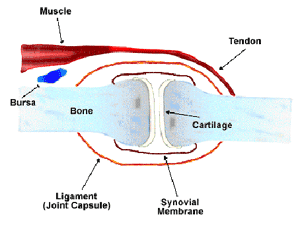Lots of people were asking me lately about arthritis, osteoarthritis and osteoporosis and how exercise helps to prevent or improve these conditions. I decided to do research about these diseases and find the most effective exercise program to prevent or improve conditions caused by them.
1. Arthritis
There are over 120 kinds of arthritis, all of which have something to do with one or more joints in the body. The word arthritis means “inflammation of the joint.” The problem is that in many kins of arthritis, the joint is not inflamed. A better definition might be “problems with the joint, or the ligaments, tendons, and muscles near the joint.”
Now that you understand what arthritis means, the next step is to understand what a joint looks like and what the various parts do.
Where arthritis attacks

1. Cartilage
The end of each bone is covered with cartilage, a tough material that cushions and protects the ends of the bone.
2. Synovial membrane
Around each joint is the synovial sac, which protects the joint and also secretes the synovial fluid, which oils the joint.
3. Bursa
A bursa is a small sac that is not part of the joint but is near the joint. It contains a fluid that lubricates the movement of muscle: muscle across muscle and muscle across bones.
4. Muscle
The muscles are elastic tissues that, by becoming shorter and longer, move the bones and thus move you.
5. Tendon
The tendons are fibrous cords that attach the muscles to the bones.
6. Ligament
The ligaments are fibrous cords, much shorter than tendons, that attach bone to bone and make up the joint capsules.
When someone says, “I have arthritis,” it means that something is wrong with one or more of these parts. For example, when the synovial membrane becomes inflamed, this is true arthritis. The joint is inflamed. However, if the muscle becomes stretched from overexercise or is injured, this is not arthritis. The joint itself is not affected.